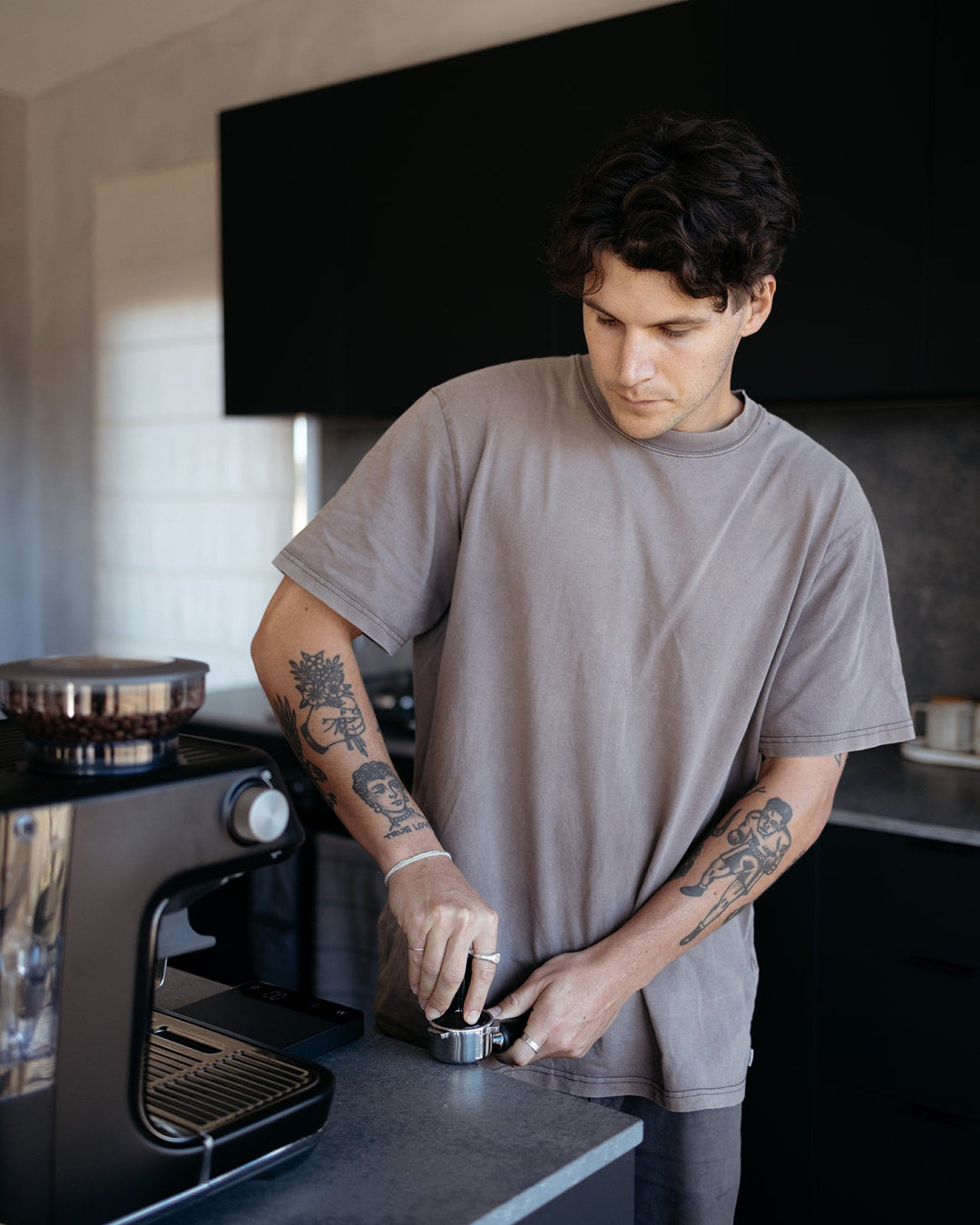The Coffee Lover’s Guide to SOE Single Origin Espresso Varieties
Wiki Article
Comprehending Coffee Beans: the Trip From Coffee to Blended Coffee Beans

The Beginnings of Coffee: A Worldwide Point Of View
While you could think of coffee as a modern staple, its origins map back centuries, intertwining with societies across the world. The story begins in Ethiopia, where legend states a goat herder named Kaldi discovered the invigorating impacts of coffee beans after observing his goats frolicking energetically after consuming them.As profession paths expanded, coffee made its means to Europe in the 17th century, rapidly acquiring appeal. Each society included its unique twist to coffee preparation, enhancing its history.
Growing and Harvesting of Espresso Beans
As coffee's journey evolved, the emphasis changed to the farming and harvesting of particular bean varieties, especially those made use of for coffee. You'll discover that espresso beans typically originate from Arabica or Robusta plants, each offering distinctive tastes. The ideal expanding problems consist of high altitudes and rich, well-drained soil, which enhance the beans' quality.During the harvest, selecting approaches vary. In some regions, employees hand-pick ripe cherries, ensuring just the most effective fruit goes to processing. In other areas, mechanical farmers are utilized, especially on larger ranches. When the cherries get to peak ripeness for optimum flavor., timing is essential; you desire to harvest.
As soon as gathered, the beans are prepared for handling, which is important in establishing their final preference. Comprehending the cultivation and collecting processes offers you insight right into what goes right into your favorite espresso, enriching your recognition for each mug.
Handling Techniques: From Cherry to Bean
Currently that you've found out about collecting espresso beans, let's discover exactly how those cherries transform into the coffee beans you enjoy. You'll see how various harvesting techniques influence flavor, followed by the crucial steps of fermentation and drying out. We'll damage down the milling and grading process that identifies your coffee's top quality.Gathering Strategies Discussed
When it involves coffee, understanding harvesting methods is vital, because they straight influence the flavor and high quality of the beans you take pleasure in. There are two main approaches: selective picking and strip picking. Careful selecting entails hand-picking just ripe cherries, guaranteeing you obtain the finest quality beans. This technique typically results in a richer flavor account, though it's even more labor-intensive. On the various other hand, strip selecting methods harvesting all cherries at once, despite ripeness. While it's quicker and cheaper, this can lead to a mix of tastes, impacting the end product. Ultimately, the option of harvesting method can considerably affect your coffee experience, so it deserves understanding exactly how those beans made it to your cup.Fermentation and Drying
After harvesting, the following action in processing coffee beans play a significant duty in forming their taste. You'll find that fermentation is essential, as it aids damage down the mucilage bordering the beans, boosting their preference account. Depending upon the method, this procedure can last from a few hours to a number of days, with varying results based upon temperature level and humidity.Sun-drying enables the beans to soak up flavors from the environment, while mechanical drying warranties constant dampness levels no matter of weather condition. Correct drying is necessary to avoid mold and mildew and preserve the beans' quality, ultimately influencing your mug of coffee.
Milling and Grading Process
As fermentation and drying out established the phase for taste development, the milling and grading process warranties that only the finest coffee beans make it to your mug. This stage entails getting rid of the outer layers of the coffee cherry, including the parchment and husk. After milling, the beans are arranged by dimension and weight, making sure a consistent quality. You'll discover that grading aids identify problems and classify beans, which influences taste and aroma. High-quality beans receive a higher quality, causing a richer coffee experience. As soon as graded, the beans await product packaging and delivery, maintaining their unique attributes. This meticulous process is vital for providing the remarkable taste you enjoy in every sip of your preferred mixture.Roasting Methods: Opening Taste Prospective
When you roast coffee beans, the technique you select can substantially influence the flavor profile. Understanding the relationship in between time, temperature level, and toasting methods is essential to exposing the potential of your brew. Allow's discover exactly how these aspects integrated to produce the ideal cup.Toasting Techniques Described
While you may believe that all coffee roasting methods generate the exact same outcomes, the fact is that each method exposes distinct flavor possibilities in the beans. You can select between methods like drum toasting, air roasting, and even standard pan roasting. Drum toasting utilizes a rotating drum to equally disperse heat, boosting caramelization and creating a balanced taste. Air roasting, on the other hand, flows hot air around the beans, advertising a lighter roast with noticable acidity. Frying pan roasting allows for hands-on control but needs constant focus to avoid burning. Each approach has its nuances, so trying out various techniques can assist you discover the best roast that aligns with your preference preferences. Delight in the trip of finding your ideal mug!
Effect On Flavor Profile
Different toasting techniques not just influence the procedure however likewise substantially influence the taste profile of the coffee beans. When you choose a light roast, you'll experience intense acidity and floral notes, showcasing the bean's beginning. In comparison, a medium roast equilibriums level of acidity with sweet taste, usually disclosing chocolatey touches. Dark roasts, on the various other hand, bring out vibrant, smoky flavors, occasionally concealing the bean's special features. Each method discloses different oils and substances, leading to a wide variety of flavors. By experimenting with numerous roasting styles, you can find which accounts reverberate with your palate. Recognizing these subtleties assists you value the artistry behind your mug of coffee, improving your general experience with every sip.Time and Temperature Level Aspects
To release the full flavor potential of coffee beans, both time and temperature level throughout the roasting procedure play significant duties. When roasting, you'll locate that greater temperatures can promptly create flavors, yet if you hurry it, you might wind up with burnt notes. On the other hand, reduced temperatures allow for a much more progressive taste growth, showcasing the beans' distinct features.
Timing is equally as vital; prolonging the roast also long can lead to a loss of level of acidity and illumination, while too short a roast could leave the beans underdeveloped. Discovering that wonderful spot requires method and experimentation. By adjusting these variables, you can reveal the rich, intricate flavors hidden within each bean, developing a really amazing coffee experience.
The Art of Mixing: Crafting Distinct Coffee Accounts

Beginning by picking a base coffee that provides a strong structure. A brilliant Ethiopian bean can bring fruitiness, while an abundant Brazilian coffee includes body.
As you blend, maintain in mind that each combination tells a tale. You're not simply making coffee; you're producing an experience. Take your time, preference often, and delight in the journey of discovering your trademark mix - Single Origin Espresso.
Developing Methods: How Prep Work Influences Flavor
Blending coffee opens up a domain name of flavor opportunities, yet exactly how you brew that blend can substantially affect your final cup. Various brewing techniques remove special tastes and fragrances, so it's essential to select carefully. For circumstances, a French press permits oils and debris to remain, developing a rich, full-bodied experience. On the other hand, a pour-over highlights the coffee's quality and illumination, excellent for showcasing fragile notes.Espresso, with its high pressure, creates a concentrated shot that emphasizes sweetness and crema. If you like a lighter brew, think about a cold mixture method; it generates a smooth, much less acidic taste.
Inevitably, trial and error is key. Readjusting variables like water temperature, grind dimension, and make time can transform your coffee's account. Accept the art of developing to discover the flavors concealed in your coffee blends. The right method can raise your experience to brand-new heights.
The Future of Coffee: Sustainability and Advancement
As the coffee sector develops, sustainability and advancement are becoming important for resolving environmental difficulties and conference customer needs. You'll notice that more coffee business are embracing environmentally friendly techniques, from sourcing beans fairly to executing sustainable farming techniques. These shifts not only assist the world yet additionally boost the quality of the coffee you delight in.You could see developments like naturally degradable packaging and water-saving developing techniques that decrease waste. Advanced technology, such as blockchain, is additionally becoming popular, guaranteeing transparency in the supply chain, which allows you to trace SOE your coffee back to its origins.
On top of that, spending in local communities and supporting farmers through reasonable profession campaigns fosters a much more sustainable coffee environment. As you sip your next cup, keep in mind that your selections can add to a brighter future for coffee. By going with lasting brands, you're not just taking pleasure in a beverage; you're making a positive influence on the globe.
Frequently Asked Concerns
What Is the Difference In Between Arabica and Robusta Beans?
Arabica beans are smoother, sweeter, and have a higher acidity, while robusta beans are more powerful, a lot more bitter, and include even more high levels of caffeine. You'll discover these distinctions in flavor and aroma when making your coffee.Just How Does Elevation Affect Coffee Bean Taste?
Elevation influences coffee bean taste significantly. Higher altitudes create beans with brighter level of acidity and complex tastes, while lower elevations typically yield beans that are much heavier and less nuanced. You'll observe these distinctions in your cup!What Are the Health Perks of Drinking Coffee?
Consuming coffee can boost your energy, boost mental focus, and also enhance physical efficiency. It's abundant in antioxidants, might decrease the risk of certain diseases, and can advertise a much healthier metabolic process when eaten in small amounts.Can Coffee Beans Be Reused for Brewing?
Yes, you can recycle coffee beans for developing, however the taste might be weaker. If you appreciate experimenting, try recycling them in various ways, like chilly mixtures or including in healthy smoothies for an added kick.Just how Should I Store Coffee Beans for Freshness?
To keep your coffee beans fresh, keep them in an impermeable container in an awesome, dark location. Avoid exposing them to warmth, moisture, or light, as these aspects can promptly weaken their flavor and aroma.Comprehending Coffee Beans: the Trip From Espresso to Blended Coffee Beans.
Currently that you have actually learned about harvesting espresso beans, let's discover how those cherries change right into the coffee beans you enjoy.When you roast coffee beans, the approach you pick can drastically affect the flavor account - Single Origin Espresso.While you could assume that all coffee toasting approaches generate the exact same outcomes, the reality is that each method discloses unique taste possibilities in the beans.Various toasting techniques not only influence the procedure but also considerably impact the flavor account of the coffee beans
Report this wiki page